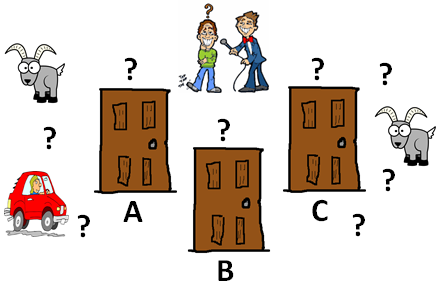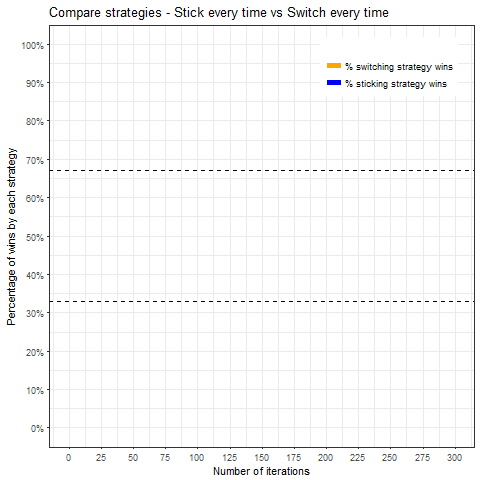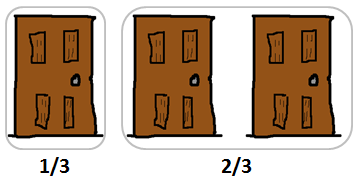The Monty Hall problem is a classic probability conundrum which on the surface seems trivially simple but, alas, our intuition can lead us to the wrong answer. Full disclosure: I got it wrong when I first saw it! Here is the short Wikipedia description of the problem:
Suppose you’re on a game show, and you’re given the choice of three doors: Behind one door is a car; behind the others, goats. You pick a door, say No. 1, and the host, who knows what’s behind the doors, opens another door, say No. 3, which has a goat. He then says to you, “Do you want to pick door No. 2?” Is it to your advantage to switch your choice?

If you haven’t seen the problem before, have a guess now before reading on – what would you do, stick or switch? My instinctive first intuition was that it does not matter if I stick or switch. Two doors unopened, one car, that’s a 50:50 chance right there. Was I right?
Method 1: Bayes’ Theorem
Let’s tease it out using Bayes’ Theorem:
P(A|B) = P(B|A) * P(A) / P(B)
That’s the generic form of Bayes’ Theorem. For our specific Monty Hall problem let’s define the discrete events that are in play:
P(A) = P(B) = P(C) = 1/3 = the unconditional probability that the car is behind a particular door.
Note I am using upper case notation for our choice of door and as you see below I will use lower case to denote the door that Monty chooses to open.
P(a) = P(b) = P(c) = 1/2 = the unconditional probability that Monty will open a particular door. Monty will only have a choice of 2 doors because he is obviously not going to open the door you have selected.
So let’s say we choose door A initially. Remember we do not know what is behind any of the doors – but Monty knows. Monty will now open door b or c. Let’s say he opens door b. We now have to decide if we want to stick with door A or switch our choice to door C. Let’s use Bayes’ Theorem to work out the probability that the car is behind door A.
P(A|b) is the probability that the car is behind door A given Monty opens door b – this is what we want to compute, i.e. the probability of winning if we stick with door A
P(b|A) is the probability Monty will open door b given the car is behind door A. This probability is 1/2. Think about it, if Monty knows the car is behind door A, and we have selected door A, then he can choose to open door b or door c with equal probability of 1/2
P(A), the unconditional probability that the car is behind door A, is equal to 1/3
P(b), the unconditional probability that Monty opens door b, is equal to 1/2
Now we can write out the full equation:
P(A|b) = P(b|A) * P(A) / P(b) = (1/2) * (1/3) / (1/2) = 1/3
Hmmm, my intuition said 50:50 but the math says I only have a 1/3 chance of winning if I stick with door A. But that means I have a 2/3 chance of winning if I switch to door C. Let’s work it out and see.
P(C|b) is the probability that the car is behind door C given Monty opens door b – this is what we want to compute, i.e. the probability of winning if we switch to door C
P(b|C) is the probability Monty will open door b given the car is behind door C. This probability is 1. Think about it, if Monty knows the car is behind door C, and we have selected door A, then he has no choice but to open door b
P(C), the unconditional probability that the car is behind door C, is equal to 1/3
P(b), the unconditional probability that Monty opens door b, is equal to 1/2
Now we can write out the full equation:
P(C|b) = P(b|C) * P(C) / P(b) = 1 * (1/3) / (1/2) = 2/3
There it is, we have a 2/3 chance of winning if we switch to door C and only a 1/3 chance if we stick with door A.
Method 2: Write code to randomly simulate the problem many times
Bayes’ Rule is itself not the most intuitive formula so maybe we are still not satisfied with the answer. We can simulate the problem in R – grab my R code here to reproduce this graphic – by simulate I mean replay the game randomly many times and compare the sticking strategy with the switching strategy. Look at the results in the animation below and notice how as the number of iterations increase the probability of success converges on 1/3 if we stick with first choice every time and it converges on 2/3 if we switch every time.

Simulating a problem like this is a great way of verifying your math. Or sometimes, if you’re stuck in a rut and struggling with the math, you can simulate the problem first and then work backwards towards an understanding of the math. It’s important to have both tools, math/statistics and the ability to code, in your data science arsenal.
Method 3: Stop and think before Monty distracts you
Ok, let’s say we’re still not happy. We’re shaking our head, it does not fit with our System 1 thinking and we need a little extra juice to help our System 2 thinking over the line. Forget the math, forget the code, think of it like this:
You have selected one of three doors. You know that Monty is about to open one of the two remaining doors to show you a goat. Before Monty does this, ask yourself, which would you rather? Stick with the one door you have selected or have both of the two remaining doors. Yes, both, because effectively that is your choice: stick with your first choice or have both of the other doors.

Two doors or one, I know what I’d pick!
Parting thoughts
Coming at a problem from different angles: math, code, visualizations, etc, can help us out of a mental rut and/or reassure us by verifying our solutions. On the flip side, even when we ourselves fully understand a solution, we often have to explain it to a client, a manager, a decision maker or a young colleague who we are trying to teach. Therefore it is always a valuable exercise to tackle a problem in various ways and to be comfortable explaining it from different angles. Don’t stop here, google Monty Hall and you will find many other varied and interesting explanations of the Monty Hall problem.